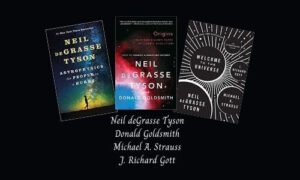Theoretical Physcist - Michio Kaku
Michio Kaku is an American theoretical physicist, futurist, and popularizer of science. Michio Kaku is the co-founder of String Field Theory and is the author of international best-selling books such as Hyperspace, Visions, and Beyond Einstein.
He is a professor of theoretical physics in the City College of New York and CUNY Graduate Center. Kaku has written several books about physics and related topics, has made frequent appearances on radio, television, and film, and writes online blogs and articles.
The Future of Humanity: Terraforming Mars, Interstellar Travel, Immortality, and Our Destiny Beyond Earth
Michio Kaku writes his thought-provoking ideas of space exploration in an easy to read format.
Moving human civilization to stars is increasingly becoming a scientific possibility and a necessity.
Whether in the near future due to climate change and the depletion of finite resources, or in the distant future due to catastrophic cosmological events, we must face the reality that humans will one day need to leave planet Earth to survive as a species.
World-renowned physicist and futurist Michio Kaku explores in rich, intimate detail the process by which humanity may gradually move away from the planet and develop a sustainable civilization in outer space.
He reveals how cutting-edge developments in robotics, nanotechnology, and biotechnology may allow us to terra form and build habitable cities on Mars. He then takes us beyond the solar system to nearby stars, which may soon be reached by nano ships traveling on laser beams at near the speed of light.
Finally, he brings us beyond our galaxy, and even beyond our universe, to the possibility of immortality, showing us how humans may someday be able to leave our bodies entirely and laser port to new havens in space. Kaku takes readers on a fascinating journey to a future in which humanity may finally fulfill its long-awaited destiny among the stars.
Some excerpts from the book:
“Terraforming Mars is a primary goal for the twenty-second century. But scientists are looking beyond Mars as well. The most exciting prospects may be the moons of the gas giants, including Europa, a moon of Jupiter, and Titan, a moon of Saturn. The moons of gas giants were once thought to be barren hunks of rock that were all alike, but they are now seen as unique wonderlands, each with its own array of geysers, oceans, canyons, and atmospheric lights. These moons are now being eyed as future habitats for human life.”
“It’s easy to imagine that, in the future, telepathy and telekinesis will be the norm; we will interact with machines by sheer thought. Our mind will be able to turn on the lights, activate the internet, dictate letters, play video games, communicate with friends, call for a car, purchase merchandise, conjure any movie-all just by thinking. Astronauts of the future may use the power of their minds to pilot their spaceships or explore distant planets. Cities may rise from the desert of Mars, all due to master builders who mentally control the work of robots.”
“On average, animals that eat 30 percent fewer calories live 30 percent longer. This has been amply demonstrated with yeast cells, worms, insects, mice and rats, dogs and cats, and now primates. In fact, it is the only method that is universally accepted by scientists to alter the life span of all animals that have been tested so far.”
The Future of the Mind: The Scientific Quest to Understand, Enhance, and Empower the Mind
The secrets of the living brain are revealed by a battery of high tech brain scans devised by physicists.
What was science fiction has become a startling reality as recording memories, telepathy, videotaping our dreams, mind control, avatars, and telekinesis are not only possible; they already exist.
The Future of the Mind brings a topic that once belonged solely to the province of science fiction into a startling new reality. This scientific tour de force unveils the astonishing research being done in top laboratories around the world—all based on the latest advancements in neuroscience and physics—including recent experiments in telepathy, mind control, avatars, telekinesis, and recording memories and dreams. The Future of the Mind is an extraordinary, mind-boggling exploration of the frontiers of neuroscience. Dr. Kaku looks toward the day when we may achieve the ability to upload the human brain to a computer, neuron for neuron; project thoughts and emotions around the world on a brain-net; take a “smart pill” to enhance cognition; send our consciousness across the universe; and push the very limits of immortality.
Some excerpts from the book:
“The brain weighs only three pounds, yet it is the most complex object in the solar system.”
“It is remarkable that a gigantic, city-size computer is required to simulate a piece of human tissue that weighs three pounds, fits inside your skull, raises your body temperature by only a few degrees, uses twenty watts of power, and needs only a few hamburgers to keep it going.”
“there are as many stars in our galaxy (about 100 billion) as there are neurons in your brain; your cell phone has more computing power than NASA had when it landed Apollo 11 on the moon“
“consciousness is the fundamental entity in the universe, more fundamental than atoms. The material world may come and go, but consciousness remains as the defining element, which means that consciousness, in some sense, creates reality. The very existence of the atoms we see around us is based on our ability to see and touch them.”
“In science fiction, telepaths often communicate across language barriers, since thoughts are considered to be universal. However, this might not be true. Emotions and feelings may well be nonverbal and universal, so that one could telepathically send them to anyone, but rational thinking is so closely tied to language that it is very unlikely that complex thoughts could be sent across language barriers. Words will still be sent telepathically in their original language.”
Parallel Worlds: A Journey Through Creation, Higher Dimensions, and the Future of the Cosmos
Michio Kaku takes us on a dizzying ride to explore black holes and time machines, multidimensional space and, most tantalizing of all, the possibility that parallel universes may lay alongside our own.
Kaku skillfully guides us through the latest innovations in string theory and its latest iteration, M-theory, which posits that our universe may be just one in an endless multiverse, a singular bubble floating in a sea of infinite bubble universes. If M-theory is proven correct, we may perhaps finally find answer to the question, “What happened before the big bang?” This is an exciting and unforgettable introduction into the new cutting-edge theories of physics and cosmology from one of the pre-eminent voices in the field.
Some excerpts from the book:
“Nobel laureate Steven Weinberg likens this multiple universe theory to radio. All around you, there are hundreds of different radio waves being broadcast from distant stations. At any given instant, your office or car or living room is full of these radio waves. However, if you turn on a radio, you can listen to only one frequency at a time; these other frequencies have decohered and are no longer in phase with each other. Each station has a different energy, a different frequency. As a result, your radio can only be turned to one broadcast at a time.Likewise, in our universe we are “tuned” into the frequency that corresponds to physical reality. But there are an infinite number of parallel realities coexisting with us in the same room, although we cannot “tune into” them.
“There is a cosmic “entanglement” between every atom of our body and atoms that are light-years distant. Since all matter came from a single explosion, the big bang, in some sense the atoms of our body are linked with some atoms on the other side of the universe in some kind of cosmic quantum web. Entangled particles are somewhat like twins still joined by an umbilical cord (their wave function) which can be light-years across. What happens to one member automatically affects the other, and hence knowledge concerning one particle can instantly reveal knowledge about its pair. Entangled pairs act as if they were a single object, although they may be separated by a large distance.” “…the laws of physics, carefully constructed after thousands of years of experimentation, are nothing but the laws of harmony one can write down for strings and membranes. The laws of chemistry are the melodies that one can play on these strings. The universe is a symphony of strings. And the “Mind of God,” which Einstein wrote eloquently about, is cosmic music resonating throughout hyperspace.”
Hyperspace: A Scientific Odyssey Through Parallel Universes, Time Warps, and the 10th Dimension
The first book-length explanation of the most exciting development in modern physics, the theory of 10-dimensional space.
The theory of hyperspace, which Michio Kaku pioneered, may be the leading candidate for the Theory of Everything that Einstein spent the remaining years of his life searching for.
How many dimensions do you live in? Three?
Maybe that’s all your commonsense sense perception perceives, but there is growing and compelling evidence to suggest that we actually live in a universe of ten real dimensions.
Kaku has written an extraordinarily lucid and thought-provoking exploration of the theoretical and empirical bases of a ten-dimensional universe and even goes so far as to discuss possible practical implications–such as being able to escape the collapse of the universe.
Some excerpts from the book:
“Some people seek meaning in life through personal gain, through personal relationship, or through personal experiences. However, it seems to me that being blessed with the intellect to divine the ultimate secrets of nature gives meaning enough to life.”
“As all matter is crushed in the final moments before doomsday, intelligent life forms may be able to tunnel into higher-dimensional space or an alternative universe, avoiding the seemingly inevitable death of our universe.”
“Srinivasa Ramanujan was the strangest man in all of mathematics, probably in the entire history of science. He has been compared to a bursting supernova, illuminating the darkest, most profound corners of mathematics, before being tragically struck down by tuberculosis at the age of 33… Working in total isolation from the main currents of his field, he was able to rederive 100 years’ worth of Western mathematics on his own. The tragedy of his life is that much of his work was wasted rediscovering known mathematics.”
“Unfortunately, string theorists are, at present, at a loss to explain why ten dimensions are singled out. The answer lies deep within mathematics, in an area called modular functions. Whenever we manipulate the KSV loop diagrams created by interacting strings, we encounter these strange modular functions, where the number ten appears in the strangest places. These modular functions are as mysterious as the man who invented them, the mystic from the East. Perhaps if we better understood the work of this Indian genius, we would understand why we live in our present universe.”





